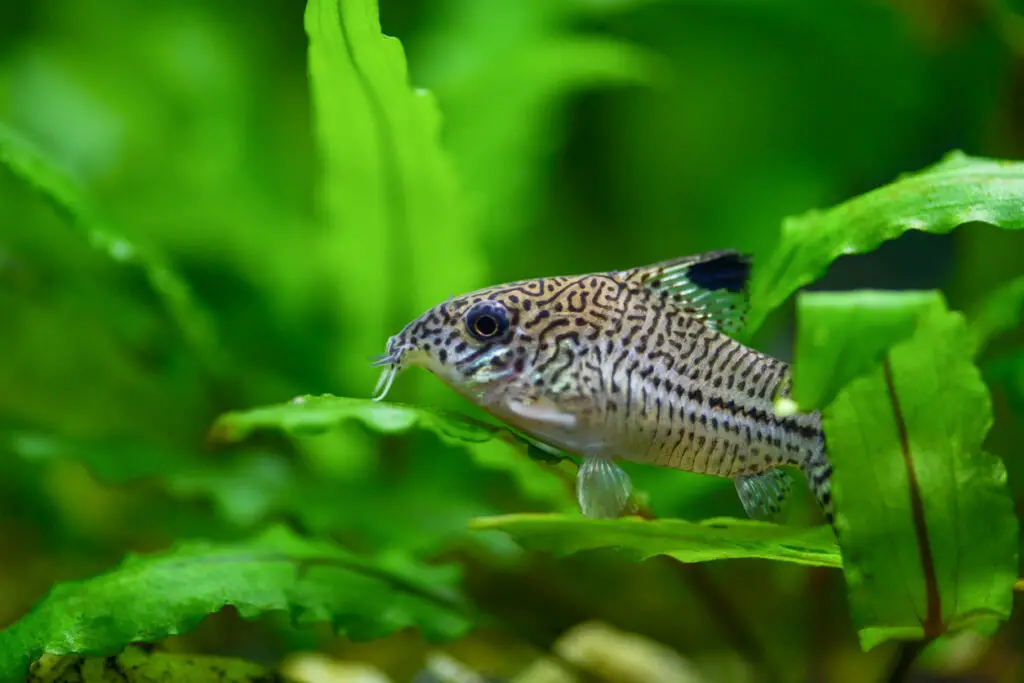There is something very special about seeing a school of tiger barbs streaming out from behind freshwater aquarium plants to greet you at feeding time.
Likewise, many people enjoy simply watching freshwater fish and other aquatic creatures carry out their lives in an attractive environment filled with healthy, robust plants.
Over the years, I have focused almost exclusively on live freshwater plants arranged in terraces or attached to driftwood as part of my aquascaping adventures.
Below I’m going to outline the benefits to keeping live aquarium plants, and then share my top 10 best (and easiest) freshwater aquarium plants.
4 Reasons to Use Freshwater Aquarium Plants

1. Freshwater Aquarium Plants Provide a Relaxing, Safe Environment for Tropical Fish
Even though some fish will not travel more than a few feet from where they were born, being in a walled enclosure can still be very stressful to them.
Live plants are a part of every fish’s native environment, so having them in the tank helps fish feel less constrained.
In addition, many aquatic creatures tend to be territorial or display aggression to other species or weaker members of their own species. Plants offer essential hiding places for more passive fish as well as ones that may not be feeling well.
2. Freshwater Aquarium Plants are Essential for Completing the Cycle of Life in the Tank
As you may already know, invisible beneficial bacteria in a fish tank break down deadly ammonia and nitrites into less toxic nitrates.
These nitrates, in turn, are very useful to live plants that use them for food.
Live plants also help complete the cycle of life in a healthy fish tank because they provide essential cover for eggs and fry.
Top Tip: If you have a large enough tank where fish can breed naturally, live plants offer the best way to ensure you will get to see new fish in the tank from time to time.
3. Freshwater Aquarium Plants make Attractive Decorations
Few people in the world today prefer looking at bare buildings, cement, or other settings that don’t have live plants.
When it comes to your fish tank, live plants enhance other decorations as well as provide a beautiful view all by themselves.
4. Freshwater Aquarium Plants Reduce the Need for Water Changes or Water Chemistry Adjustments
Aside from removing nitrates, some plants also remove various toxins from the water. While live plants will not entirely eliminate the need for occasional water chemistry adjustments, they can create significant reduction.
Author Note: I have also found that live plants virtually eliminate the need for water changes, other than routine topping off to replace water lost through evaporation.
Things to Consider As You Buy Freshwater Aquarium Plants
The process of buying live plants for your aquarium starts with knowing what function you wish the plants to serve.
Live plants help provide a better tank by taking in CO2 and giving Oxygen. Live plants can absorb other harmful chemicals while giving the tank a natural look.
Depending on the type of fish you have, the plant can offer shy fish a place to hide when nervous. It offers a shady place for fish to nap in as well.
Author Note: One practical way to use plants is to conceal the tank’s fixtures in order to make your tank more beautiful and natural looking.
The Different Types of Freshwater Aquarium Plants
When choosing the plants, it’s important to think of what you want the plant to do and where it needs to go.
A major way to divide plants is based on the location in the tank. The three areas you can find are:
- Foreground – These plants are meant to be at the front and tend towards slow growing and short plants.
- Mid-Ground – Taller than foreground and meant to be used on the tanks side and middle
- Background – These are the largest plants you will put in a tank, they can be used as shelters for the fish as well as constructing a natural looking background for your tank.
Top 10 Freshwater Aquarium Plants for Beginner and Advanced Aquarists
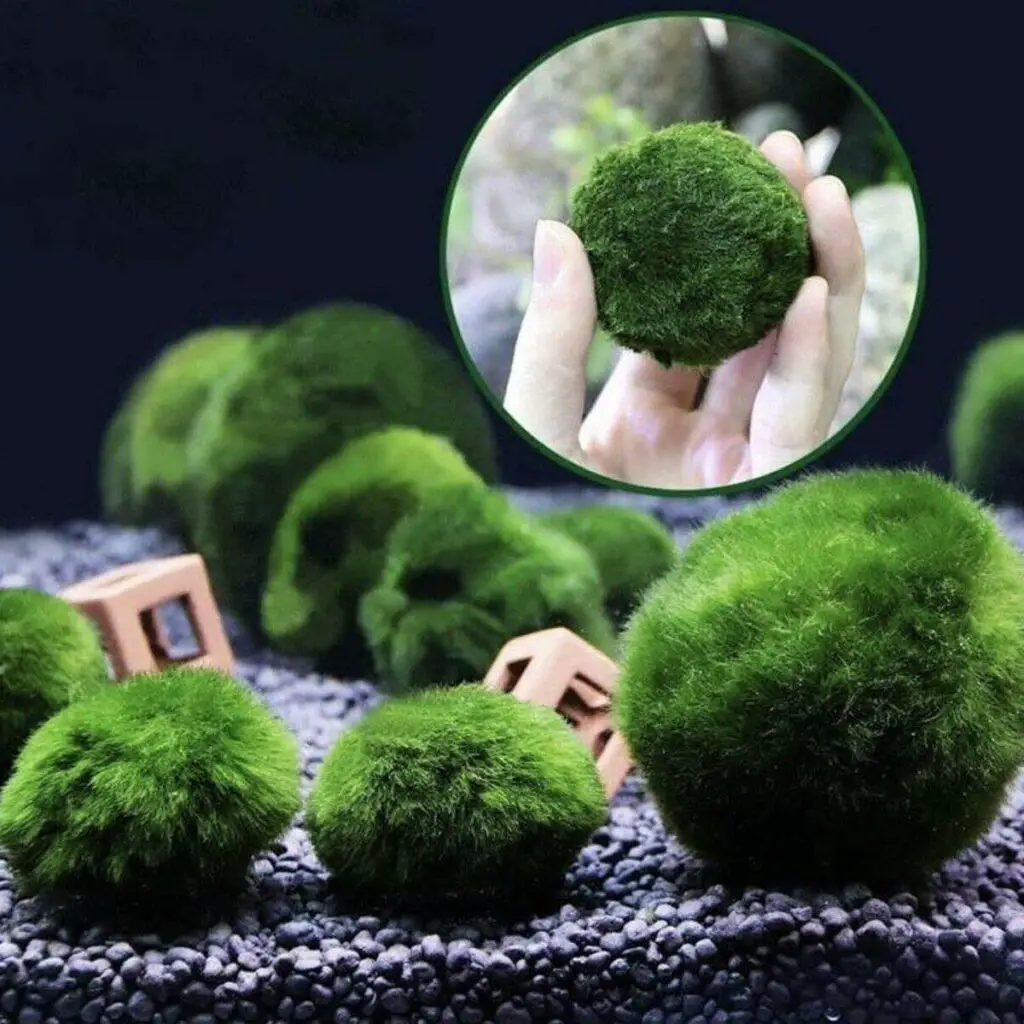
Even though they look like simple, green colored spheres, Marimo Moss Balls are truly amazing creatures in their own right.
Changes from day to night cause them to rise and sink in the tank. They will also split apart on their own as a means of propagation.
It is best suited to the foreground of the tank, or sitting on terraces at the mid level. Since it likes to move around, and is often moved by fish in the tank, however, don’t plan on keeping it in one location.
| Water Temperature | 72 – 82 degrees Fahrenheit |
| pH | 6.8 – 7.5 |
| Hardness | All |
| Lighting | Medium to bright |
| Rate of Growth | Slow to medium |
Compatibility
Marimo Moss Balls are perfect for tanks with goldfish, fan tails, bettas, and other fish that will nose at it and push it around the tank.
Not only will the fish enjoy playing with the moss balls, the movement will help ensure the entire ball gets adequate nutrition.
Since this plant doesn’t require anchoring in substrate or on other materials, it will also do fine in tanks with substrate diggers.
Other Needs
Turn Marimo Moss Balls from time to time to ensure the entire ball has access to water currents that provide nutrients for the plant.
You can also break larger moss balls into smaller pieces as a means of propagation.
Final Thoughts
Over the years, I have come back to Marimo Moss Balls more than any other aquatic plant. They are attractive, easy to care for, and can fit into any tank setting and décor.
>> Tap Here to Read More Reviews and See Today’s Price on Amazon.com <<

Even though Peacock Moss doesn’t reach enormous heights, it is a very attractive plant that easily catches your eye.
It will look fine in the foreground, mid ground, on terraces, and any other place where you need a smaller focus plant.
| Water Temperature | 77 – 86 degrees fahrenheit |
| pH | 5.8 – 7.5 |
| Hardness | All |
| Lighting | Bright |
| Rate of Growth | Moderate |
Compatibility
There are few plants that can rival the beauty of peacock moss, especially when the leaves open up to form a stunning emerald green fan shaped fern.
It is well suited to breeding tanks for egg layers, and will also provide shelter for small fish, snails, and freshwater shrimp.
Since it does well in a wide range of water chemistries, you can put it in just about any tank. It will also do fine in tanks with fish that dig in the substrate.
If you use it in tanks with fish that enjoy eating plants, it may not do well unless it has CO2 supplementation.
Other Needs
For fastest growth, use CO2, however it is not necessary to use this supplement.
Peacock Moss also requires anchoring to driftwood or other materials. Do not place it directly in substrate.
Final Thoughts
Peacock Moss is a personal favorite that I have used in many different aquariums. You can easily control its growth and enjoy watching it change in shape over time.
>> Tap Here to Read More Reviews and See Today’s Price on Amazon.com <<

These plants are absolutely fascinating to watch grow.
Place bulbs in pots at the foreground of the tank, and then keep them there until the first few light green leaves emerge. Afterward, you can move them further back in the tank and plant them directly in the substrate.
Aponogentons can easily grow 12” or more in height and then grow wider over time. With bi-monthly trimming, they serve well as background plants in small tanks.
With less trimming, they will look fine in the mid range to background of larger aquariums.
With less trimming, they will look fine in the mid range to background of larger aquariums.
| Water Temperature | 71 – 83 degrees Fahrenheit |
| pH | 6.5 – 7.5 |
| Hardness | All |
| Lighting | Medium to high |
| Rate of Growth | Very fast – once established will produce 10 – 15 leaves per month. |
Compatibility
Once Aponogetons sprout from their bulbs and establish a hearty root system, they can be placed with just about any fish, including those that enjoy snacking on plants.
Keep away from snackers and fish that like to dig in the substrate until they are established.
Other Needs
Will need trimming on a routine basis or a single plant can easily outgrow the tank. These aquatic plants do not require additional CO2.
There are several species of Aponogeton bulbs available.
Some may require Iron supplementation or other fertilizers, while others will go through a dormant period.
Final Thoughts
Aponogeton is as good choice for budget friendly tanks because you can purchase several bulbs at a time and have good healthy plants by the time the tank completes its first cycle.
They are also very easy to care for and will thrive in a variety of water chemistry conditions. That being said, if you don’t have time for monthly trimmings, this may not be a good option for tanks smaller than 20 gallons.
>> Tap Here to Read More Reviews and See Today’s Price on Amazon.com <<

This charming plant is a favorite of many aquarium keepers because it is so versatile.
It will float lazily on the surface and provide shade, or it can be anchored to the substrate or other decorations in the tank.
If you anchor it, Hornworts can get fairly tall, so they will look best in the mid and background areas of medium to large sized tanks. You can also break off pieces to use it as a foreground plant or in smaller aquariums.
| Water Temperature | 59 – 86 degrees Fahrenheit |
| pH | 6.0 – 7.5 |
| Hardness | Soft to medium |
| Lighting | Medium |
| Rate of Growth | Very fast |
Compatibility
Many fish are attracted to hornwort and like to dine on it. Try to keep it partitioned off in tanks with plant eaters until it is established. After that, you can mostly let the fish do the trimming for you!
Since this plant grows very quickly, there will be more than enough material for the plant to survive in tanks with fish that have a good appetite for live plants.
It will also do fine in tanks with substrate diggers, although you may have to simply let the plant float around in the tank or anchor it to a mat and attach that to driftwood or some other material.
Other Needs
This plant has a tendency to shed its needle like leaves when you first place it in a new setting. Later on, after the plant is established and growing well, it may start to shed again without the use of fertilizer and CO2.
Final Thoughts
Even though this plant grows well and is a favorite with plant eating fish, it produces toxins that can kill off plants that are sensitive to the poison.
These toxins will also kill off blue-green algae, so you may want to use it in heavily infested tanks.
Interestingly enough, a group of bacteria known as cyanobacteria also produce toxins that can lead to organ damage, illness and death of other inhabitants in aquatic environments.
Hornworts are one of the few plants that can absorb these toxins from the water and reduce their impact.
Overall, this is a good plant to keep in any aquarium, just make sure that other plants in the tank are compatible with it.
>> Tap Here to Read More Reviews and See Today’s Price on Amazon.com <<

Under the right conditions, this plant can produce eye catching splashes of red and green.
It will grow about 11” tall, so keep it either in the mid or background areas of the tank. Make sure there is an unobstructed view of this plant so that you watch it change colors as the leaves develop.
| Water Temperature | 72 – 83 degrees Fahrenheit |
| pH | 6.5 to 7.5 |
| Hardness | Soft to medium |
| Lighting | Medium to bright |
| Rate of Growth | Slow to moderate depending on light and nutrient availability |
Compatibility
This plant produces both roots and rhizomes, so it may not always tolerate fish that dig into the substrate. You can use pots to get around this challenge, or simply put fine mesh over terraced areas where this plant is growing.
Egg laying and territorial fish will both be drawn to this plant, and may use it during courtship, spawning, and as a territorial marker.
If you must move decorations around to disrupt territorial aggression, it will be best to keep this plant in a pot so that it can be moved around with no harm to the plant.
Other than that, it will grow well in most soft to medium water hardness tanks, including breeder tanks.
Other Needs
Red Flame Sword plants may need aquarium fertilizer from time to time. Avoid using copper based antibiotics or anything that can leach this element into the water.
Final Thoughts
Red Flame Sword plants are a favorite among aquarium hobbyists because of its brilliant color. It is may require fertilizer from time to time, but does not need CO2 supplementation.
This makes it very useful in 5 – 10 gallon tanks where you want some color, but cannot safely use CO2. It is also perfect for larger tanks where you can use it as a centerpiece, or as part of terraced features.
>> Tap Here to Read More Reviews and See Today’s Price on Amazon.com <<

This plant will get about 8” tall and provide a pleasing accent to taller background plants in large tanks.
It can also be used as a background plant in smaller aquariums.
| Water Temperature | 68 – 82 degrees fahrenheit |
| pH | 6.0 – 7.5 |
| Hardness | Soft to medium |
| Lighting | Low to medium |
| Rate of Growth | Slow to moderate depending on light |
Compatibility
Since this plant is a column feeder, it will do well fine in tanks with digging fish that live in similar water chemistries.
Other Needs
This plant will rot and die if you plant it in substrate. Its roots, however, must still be anchored to driftwood or some nutrient poor, porous material.
Final Thoughts
This is an attractive plant that will thrive in both large and small tanks. It is very good in smaller tanks where you cannot use CO2 supplementation, and will also do well in low light conditions.
Therefore, if you are setting up a tannin rich tank for bettas or other creatures that enjoy darker water, Java Ferns offer many benefits.
>> Tap Here to Read More Reviews and See Today’s Price on Amazon.com <<

Dwarf Hairgrass is often considered a carpeting plant, so you can use it in the foreground, or any area of the tank where you want to cover up an empty patch.
It can grow easily in mats anchored to driftwood, caves, or other structures, as well as on the substrate.
Unlike Staurogyne Repens, I don’t recommend it for vertical growth along an aquarium wall. Mosses and other plants will provide a more attractive wall covering.
| Water Temperature | 70 – 83 degrees fahrenheit |
| pH | 6.0 – 8.0 |
| Hardness | Medium to hard |
| Lighting | Medium to bright |
| Rate of Growth | Medium |
Compatibility
Avoid using Dwarf Hairgrass in tanks with fish that like to dig in the substrate.
Since this plant propagates across the substrate, it may not be feasible to keep it in pots.
Once established, you can keep this plant with tiger barbs and other fish that may snack on plants from time to time.
It is also one of the best natural plants for a breeder tank because it provides plenty of places for eggs and fry to remain hidden.
Other Needs
Requires fertilizer in new tanks, but will do fine without it once tankmates supply more nitrates.
Final Thoughts
Dwarf Hairgrass is an attractive, relatively low maintenance plant that can be used to create carpets and enhance hiding places for small or shy fish.
Since it does not require CO2 supplementation, it can be used in small tanks without much difficulty.
That being said, it may have a hard time at the beginning in new tanks as well as when newly planted in tanks with fish that like to eat plants. Later on, however, it will work fine even with more voracious snackers.
>> Tap Here to Read More Reviews and See Today’s Price on Amazon.com <<

Even though this carpeting plant only reaches about 4” tall, it has attractive leaves that easily compete with larger plants in the tank.
It can be used as a foreground plant in aquariums of all sizes. Staurogyne repens will also look good when grown in mats on caves or anchored to driftwood.
In larger tanks, you may also want to create vertical mats that will cover the back wall of the aquarium.
| Water Temperature | 68 – 82 degrees fahrenheit |
| pH | 6.5 – 7.5 |
| Hardness | Medium |
| Lighting | Medium to strong |
| Rate of Growth | Medium to fast |
| Compatibility | This plant will grow fast enough togenerate a beautiful carpet in your aquarium, but not fast enough to tolerate fish eating the leaves. It’s root system is also not tolerant of fish that dig in the substrate. If you do not want a carpet effect, however, you can place it in pots and still have a nice looking free-standing plant. |
| Other Needs | CO2 supplementation and aquarium fertilizer. |
Compatibility
This plant will grow fast enough to generate a beautiful carpet in your aquarium, but not fast enough to tolerate fish eating the leaves.
Its root system is also not tolerant of fish that dig in the substrate. If you do not want a carpet effect, however, you can place it in pots and still have a nice looking free-standing plant.
Other Needs
CO2 supplementation and aquarium fertilizer is required.
Final Thoughts
This plant does make beautiful, unique looking carpets.
On the flip side, however, it does require CO2 supplementation which means you should not use it in small tanks where CO2 injection systems can increase the risk of suffocating other inhabitants of the tank.
>> Tap Here to Read More Reviews and See Today’s Price on Amazon.com <<
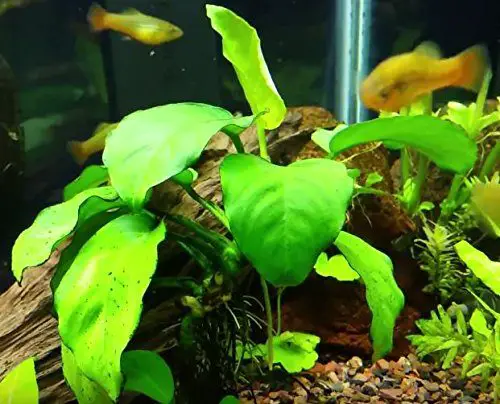
Since this plant can grow up to 16” tall, it is suitable for mid ground or as a background aquarium plant in medium to large sized tanks.
Its coloration and beautifully shaped leaves make it a useful side focus plant that will not overshadow the brilliance of Red Flame Swords or other more colorful centerpiece plants.
| Water Temperature | 72 – 82 degrees fahrenheit |
| pH | 6.5 – 7.5 |
| Hardness | Soft to medium |
| Lighting | Medium |
| Rate of Growth | Moderate |
Compatibility
As a general rule, most fish that dine on plants look for soft, tender leaves. Even larger fish that don’t mind tougher leaves will soon stop nibbling on Anubias barteri.
The root systems on this plant are also robust, so it will do fine in tanks with fish that like to dig in the substrate.
Other Needs
CO2 supplementation and root fertilizer is required.
Final Thoughts
The need for CO2 supplementation can pose a challenge in large tanks where you are using overstocking to manage aggressiveness. Other than that, it will still work well in large tanks with a wider range of fish.
>> Tap Here to Read More Reviews and See Today’s Price on Amazon.com <<
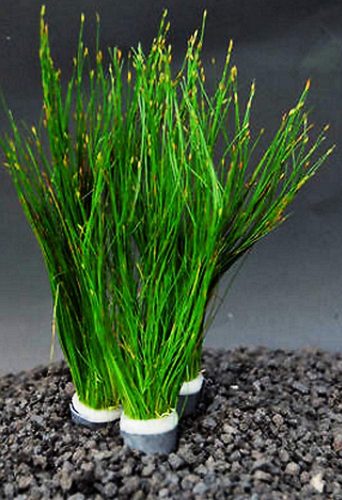
Tall Hairgrass looks just like Dwarf Hairgrass, only it grows up to 20” tall.
As such, it will not work well as a carpet plant or in smaller tanks. Instead, it provides lovely tall green stands that can be used in the back corner of medium to large sized aquariums.
You may also want to keep patches of it in breeder tanks where the fish prefer densely planted aquariums.
| Water Temperature | 59 – 77 degrees fahrenheit |
| pH | 6.0 – 9.0 |
| Hardness | Medium to hard |
| Lighting | Bright |
| Rate of Growth | Fast |
Compatibility
This plant will work well with just about any fish because it can be grown in pots. Avoid planting it in mats or in the substrate if you have fish that are known for disrupting plant roots.
Once established, its rapid growth rate makes it suitable for tanks with goldfish, fan tails, and others that enjoy consuming plants.
Other Needs
CO2 supplementation and root fertilizer is required.
Final Thoughts
The need for CO2 supplementation is always a point against any plant because of the risks associated with the injection systems.
This plant still has a lot to offer in larger aquariums where its rapid growth makes it a powerhouse in terms of absorbing nitrates and providing good hiding places for small fish and freshwater shrimp.
>> Tap Here to Read More Reviews and See Today’s Price on Amazon.com <<
Things to Look for When Buying Freshwater Aquarium Plants
Not so long ago, most aquarium keepers had to rely on the local pet shop when it came to buying aquarium plants.
Others living near ponds or other sources of freshwater could try harvesting native plants, however the risk of bringing aquatic diseases into the tank presented many challenges.
Today, online purchasing options give you access to hundreds of species of plants from around the world. With all these options, however, you will still need to make some choices to ensure the plants will thrive in your tank.
Before you purchase live aquarium plants, here are some things you should think about:
How the plant obtains nutrients
The most healthy aquarium setups use plants that feed through their roots as well as plants that take nitrates directly from the water column.
This is the best way to ensure the plants in tank are removing nitrates and water toxins regardless of where they may be in the tank.
Water Parameters
As with terrestrial plants, some aquatic plants do better in acidic waters, while others prefer a neutral or alkaline pH.
Aquatic plants may also be sensitive to the amount of minerals (hardness) dissolved in the water, aquarium lighting, and the water temperature.
Top Tip: If your tank’s water chemistry does not fall within the optimal parameters for the plant, it is best to look for a more compatible species. Your life will be so much easier!
Supplemental Needs
Some plants may require more carbon dioxide than what fish and other creatures in the tank can provide. Unfortunately, carbon dioxide injection systems are not well suited to small tanks.
If they are not set up correctly, they can let too much CO2 into the tank and suffocate the fish.
Insofar as budget, the need for trace elements, other fertilizers, and other aquarium supplies can be a challenge if you have very large tanks.
While you can still reduce the cost by using terraces and pots, beginners may want to focus more on plants that will thrive on waste produced by other inhabitants in the tank.
Maintenance Needs
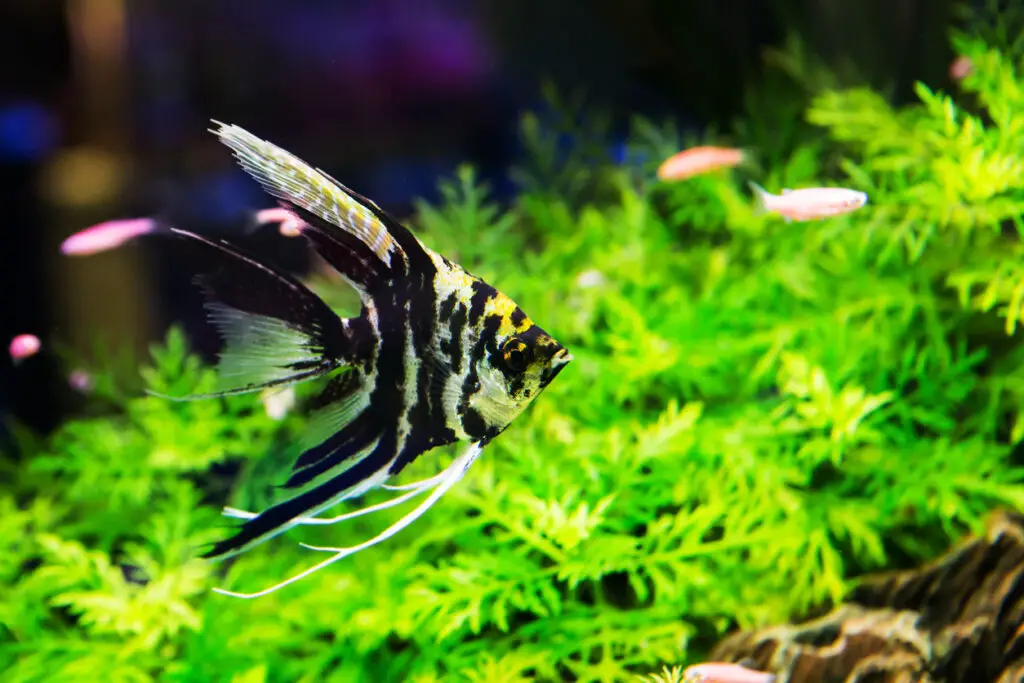
For the most part, healthy plants should only need trimming from time to time. Plants that produce off shoots or propagate from spreading rhizomes may also need separating in order to ensure new plants thrive.
The main challenge here is determining if you have enough time available to trim plants. While most will do fine with a monthly trimming, you may have to trim bi-weekly or more in smaller tanks with rapidly growing plants.
When tanks become too cramped or nutrients are insufficient, the plants may release carbon dioxide, which poses a threat to other inhabitants. Eventually, nitrate starved plants will also die off and generate ammonia.
Therefore, trimming is truly essential for good plant maintenance. If you do not have time to do the job correctly, try to focus on slower growing or smaller plants that will fit your schedule.
Compatibility
Aside from fighting with each other, fish can also wreak havoc on plants. Some normally eat plants as a main part of their diet, and will simply consider the plants a source of nutrition.
Other fish dig in the gravel for things to eat, or for building nests. These fish can disrupt roots, which can kill some plants.
When it comes to tankmate compatibility, you should consider the nature of the fish as well as the water conditions they will both live in.
While most novice aquarium keepers don’t give it much thought, eventually you may want to keep more fragile plants such as Madagascar Lace Aponogeton, or plants that have very brittle leaves.
Unfortunately, even if fish brush up against fragile plants, it can cause their leaves to tear or break apart.
It’s very important to make sure the plant leaves and stems are sturdy enough to be probed by curious fish and other creatures that live in the tank.
Disease free certification
Once your aquarium is established, you may still want to add new plants from time to time. Even though opportunistic infections already exist in every aquatic setting, it is best to avoid plants that carry flukes, worms, other parasites, or their eggs.
Disease free certification doesn’t mean you should skip the quarantine process, however it may reduce the risk somewhat.
Root, Stem, and Leaf Health
No matter how carefully you choose an aquarium plant seller, there is always a chance that some plants will not arrive in good condition.
Broken leaves, unhealthy stems, leggy growth, or root damage can all point to a plant that may not do well.
If the damage is minimal, the plant may pick up and begin to thrive during the quarantine period. In situations where the plant is in bad condition or dead, you should make use of any warranties that come with the purchase.
Final Thoughts on Freshwater Aquarium Plants
Live aquarium plants are indispensable when it comes to creating a healthy underwater aquascape for fish and other creatures.
Top Tip: Growing these freshwater aquarium plants can be very easy if you choose ones that are compatible with your aquarium setup and its inhabitants.
The 10 plants featured in this article will get you off to a good start, and are likely to be species that you will continue using for decades to come and in many tanks.
